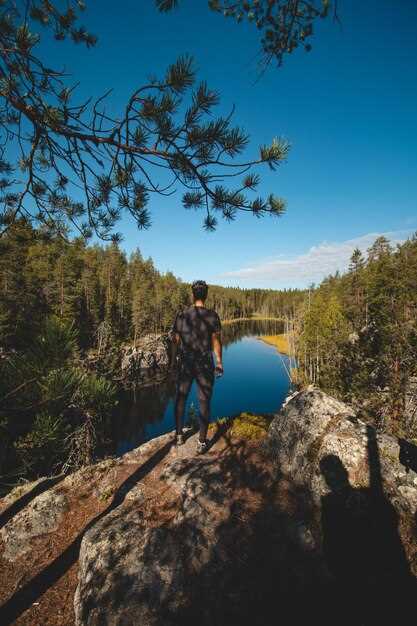Begin with a sunrise walk along Cadillac Mountain to enjoy calm light and very clear views. People from states across New England and beyond converge later, but early hours grant a cleaner photograph opportunity as the coast unfurls between pine and rock. Actually, the first light reveals colors you’ll chase for the rest of the day.
From there, pick two to three options for the day: Jordan Pond Path, Ocean Path, and Park Loop Road offer very different flavors. Between trails, you’ll find a quiet spot for shoreline ramble, quick bites, and a few lakes reflections that make for a memorable photograph. Some visitors walked the Shore Path at dusk, though the calm hours reveal more intimate spots. Grab a quick bite at a harbor shack between treks to keep energy steady. Each spot on the trail offers a different mood.
For photography, arrive early at Sand Beach, Otter Point, or Schoodic Point to capture a range of tones. If you want options, try a shoreline walk and a forest ramble; you’ll notice how light shifts and how a spot of pink near cranberry shrubs adds color to a scene. Even at popular trails, you can find quieter corners if you keep moving, which helps you photograph more than one mood, actually.
Dining in Bar Harbor blends casual and fine dining options. In town, you’ll find seafood shacks and refined eateries with lobster and seasonal produce. Some spots offer cranberry-forward dishes that echo the region; for a flavorful contrast, try a mid-range option with local fare. If you’re after something lighter between hikes, a cafe in Northeast Harbor provides a quiet alternative with similar coastal vibes. A small copita of cranberry juice can be a refreshing end to a meal if you want a coastal nod in your tasting notes.
Practical tips help you fit more into the day. Park passes, shuttle options along the loops, and early parking at popular spots save time. If you drive from Maine’s interior, you’ll reach Acadia after a few hours on the highway; this is a reasonable plan for a long weekend in some states. For a calmer pace, pace your hiking and reserve a lakes view for late afternoon, then wrap with a short, scenic ramble along the Ocean Path. Simpler routes often yield stronger memories than aggressive itineraries.
Top Tips for Visiting Acadia National Park
Book lodging and major tours well in advance; reservations fill quickly in peak seasons. Many visitors come from neighboring states for weekend trips.
Grab maps at the visitor center or download offline copies, and plan your entire day to minimize backtracking and long waits. Just verify park hours on the day of your visit.
If you are a lover of island life and wildlife, plan dawn visits along the coastline for otter sightings; waters are typically calm in the early hours, particularly for photos, and you can step down to rocky ledges with care.
To pace yourself, choose two or three moderate hikes with features on the coast and through spruce forests; take breaks at scenic overlooks and keep water handy. Some sections can be difficult after wet weather.
Parking and access vary by trailhead; check fees and shuttle options, and note that some areas require reservations for certain times or parking passes.
If you havent booked ahead, you might miss a prime lodging option on Mount Desert Island, where inns, cottages, and family places fill fast. If a date wasnt available, consider nearby Bar Harbor for access.
Reserve island tours or ranger-led programs; they offer intimate views of the coast and save you from waiting in lines.
For wildlife and photography, love the coast and keep distance from animals; they reveal features like granite shoreline and pine forests.
Best Time to Plan Your Trip: Weather, Crowds, and Sunrise Windows
Plan your trip for late May through early October to balance pleasant weather with lighter crowds and reliable sunrise visibility. Head to Cadillac Mountain 45–60 minutes before dawn to secure a close view and reserve parking near the summit, especially on weekends.
Weather varies by season: spring days are mild with cool mornings; summer brings daytime highs in the 70s to low 80s and cooler nights; fall offers crisp mornings and pleasant afternoons. The coastline is very beautiful, and the light at sunrise can be pretty dramatic when skies are clear. You’ll leave with memories you’ve ever had.
Entrance, parking, lodging: The Hulls Cove entrance provides a straightforward start to the park, and parking near popular spots can fill very early in peak months. For lodging, outside options on Mount Desert Island or Bar Harbor offer better access to dining and beaches while keeping you close to the entrance. The carriage roads, built with Rockefeller Jr. funds, provide built-in bicycle routes that stay off main roads and offer a relaxing day out.
Sunrise windows and viewpoints: The earliest sunrise draws crowds to three reliable points along Park Loop. The best windows run from late May through early September; head out 30–45 minutes before sunrise to catch colors and beat the rush. If the summit is crowded, try the Great Head overlook or a Sand Beach headland view for a different coastline perspective. What follows is a simple plan you can reuse on future trips. The same plan works on weekdays and weekends.
Three routes for a balanced day: The day follows a three-route pattern: one scenic Park Loop drive for coastline views, one carriage-road bicycle ride, and one coastal walk. The routes offer car-light experiences and easy grades, with parking at trailheads that can fill early–so arrive with enough time to spare or park outside the park and walk in.
Lodging and gear: Reserve lodging well in advance on Mount Desert Island or Bar Harbor; outside options can offer better parking and dining choices. Bring enough water, a hat, sunscreen, and a light rain shell to stay comfortable; if you plan to bike, include a helmet. The hulls bobbing near the Hulls Cove entrance remind you this is an island coast, making the scenery even more rewarding.
Must-Do Trails by Difficulty: From Easy Loops to Coastal Climbs
Start with Jordan Pond Loop: a 3.0-mile, flat circuit that offers gentle grades and iconic lake views. The wind drifts along the shore, and a sitting bench at the overlook invites a quick rest. This choice wont have spent hours here; you’ll have a solid, easy start that sets you up to explore other routes, including the Carriage Roads that circle around the park.
Easy options extend beyond Jordan Pond Loop: Carriage Road routes offer flat, stroller-friendly miles–many loops run 4–7 miles with scenic segments around lakes like Jordan Pond and Eagle Lake. For a waterfront alternative, Ship Harbor Trail along the eastern coast runs about 3–4 miles with benches and rocky coves along the waterfront, inviting a relaxed stroll. Pedestrians and cyclists share these surfaces, so keep to the right and signal before passing.
Moderate routes include Gorham Mountain Trail (about 1.5 miles round trip) and Ocean Path from Sand Beach toward Otter Point (roughly 4 miles round trip). These options offer rugged coastlines with cliff views and salt air, while remaining manageable for most hikers. If you love a longer coastal walk, you can extend Ocean Path to Thunder Hole by adding 1–2 miles along the waterline.
Challenging trails push your limits: Beehive Trail (about 0.8 miles one way with iron rungs) and Precipice Trail (about 0.9 miles) reward you with steep climbs and dramatic exposure along cliff faces. Start early, bring water, and expect narrow ledges and gusty wind conditions. These routes are best for experienced hikers; check current conditions and park advisories before you go.
To combine coast and park circuits, add a detour to Trenton’s waterfront, where you can sit and watch lobstermen while your companions take photos at rocky viewpoints. Great Head Trail offers a scenic 1.5-mile loop with sweeping eastern coastline views, and you can finish with a longer stretch along the Ocean Path to Bass Harbor or nearby coves, including sections where the wind shapes the cliff lines; a touch of copita wood scent on a calm day adds to the vibe. If you loved this mix, you’ll also want to explore options that connect to other coastal routes around the park.
Before you head out, grab the latest information at the visitor center or trailhead kiosks to tailor your choice to conditions and your group’s pace. Pack light, wear sturdy shoes, and plan for breaks at waterfront spots or campgrounds such as Blackwoods and Seawall, which sit near Trenton and provide convenient rests. That said, you can mix easy rounds with coastal climbs in a single day, starting with a morning Jordan Pond Loop and finishing with an oceanfront stroll as the sun dips low.
Scenic Drives and Park Loops: Camera Stops and Parking Tips

Park at Hulls Cove Visitor Center and drive Park Loop Road clockwise to hit the best camera stops with manageable crowds. The route runs along coastline, lakes, and inlets, offering high vantage points for really dramatic shots. Those pullouts let you open the door, shoot, and share the moment without blocking traffic. Maps and information boards at each stop help you find the location and plan the next one.
Key stops and what to shoot:
- Thunder Hole: capture the cauldrons of waves; use a fast shutter to freeze spray or a slower one for texture, depending on wave action.
- Otter Point: rugged coastline; shoot with a wide lens for the horizon or a zoom for details in the inlet.
- Schooner Head Overlook: panoramic coastlines; consider a tripod for sunrise or sunset, watch for crowds in peak season.
- Sand Beach: vivid coast with pine foreground; parking is limited–arrive early or consider walking from nearby Blackwoods Campground lot.
- Jordan Pond area and Carriage Roads: for a calm lakeside moment; pull into the Jordan Pond lot and stroll a short section of the carriage path for forest reflections.
- Bass Harbor Head Lighthouse: classic lighthouse shot at golden hour; parking near the light is limited–plan accordingly.
Parking tips for a smooth day:
- Use designated lots; avoid parking on grass or along curves; this keeps access open for others and reduces risk during busy times.
- In summer, arrive before 8 a.m. or after 4 p.m. for the best chance of an open space; Blackwoods Campground area provides easy access if you’re staying there.
- Carry a lightweight tripod and a compact bag; keep gear safe in your vehicle and only set up at pullouts; practice courtesy toward other visitors.
- Check Maps and Information at Hulls Cove for current road conditions and seasonal postings; planning with the official information helps you avoid closures and find alternative parking areas.
Optional add-ons: Cadillac Mountain Summit Road for elevated views, or a Schoodic Peninsula loop if the main road is crowded; those experiences are similar in vibe and offer a quieter coastline and calm mornings–great for photography lovers in the northeast during summer. Those who love culture can pair the loop with a quick visit to Bar Harbor museums such as the Abbe Museum.
Gear and Packing List for All Seasons: What to Bring and What to Leave
Pack a single 25–30 liter daypack with a weather-ready layering system: a waterproof shell, an insulated mid-layer, breathable base layers, and a compact hydration reservoir. This keeps the load manageable itself and adapts from october winds along the north shore to bright viewing days by the ocean.
Choose sturdy, broken-in footwear and bring a light headlamp, sunscreen, sunglasses, and a brimmed hat. Add energy chews or compact snacks for eating on long stretches, and keep a small first-aid kit and map handy for downtown centers and trailheads. If you’re camping, carry a lightweight stove and a compact cooking set, but prefer ready-to-use meals to minimize kitchen gear.
Seasonal balance matters: for spring and fall, include a rain layer and a warm fleece; for summer, prioritize sun protection and hydration; for winter, add traction devices, insulated gloves, and a compact emergency blanket. Include a dry bag for electronics and a spare battery pack; it’s a simple way to protect gears as you move between beaches, lakes, and cliff points that explorers love to photograph.
Safety and etiquette guide your days: stay clear of dangerous rock slabs on wet days, keep away from precarious ledges, and respect posted closures near viewing areas. Be mindful of crowds near popular beaches and peaks, especially on weekends, and plan quieter times at known centers and visitor hubs. Respect quiet zones and choose routes that align with your fitness level, whether you’re alone or with a small group of artists and nature lovers who seek wild, undisturbed corners.
Helpful habits to streamline packing include keeping a sieur note in your map pouch to mark favorite trails, clipping a spare key to a carabiner, and listing multiple ways to reach the ocean and north shore viewpoints. This approach lets you explore the area itself, including lakeside loops and ocean-facing cliffs, without overburdening your back or slowing you down.
| Season | Key Items | 備考 |
|---|---|---|
| Spring / Fall | Waterproof jacket, fleece, moisture-wicking base layers, compact umbrella, dry bag | Variable temps; expect mist near the ocean and windy hikes at heights |
| 夏 | Sun hat, sunscreen, sunglasses, sandals or breathable shoes, hydration pack | Long days; seek shade along beaches and viewing points; watch crowds |
| 冬 | Insulated parka, waterproof boots, traction devices, headlamp, extra batteries | Cold winds; check trail conditions for dangerous ice; keep within known routes |
Wildlife Etiquette and Leave-No-Trace Practices to Protect the Park

Always secure food and trash in established bear boxes or appropriate hang systems; never leave leftovers at the picnic table. There are towns with restaurants nearby, but if you want to enjoy Acadia responsibly, plan meals to avoid attracting wildlife. Share space with nature and keep the ecosystem intact; beavers enjoyed a clean habitat yesterday, and those habits make the experience better for everyone. This arrangement keeps wildlife calm and reduces surprises, whether you 探検 the area previously or are discovering it for the first time.
Stick to established trails and viewing platforms; wandering off-trail disrupts nests and lodges that many species rely on. At the entrance to each path, follow posted guidelines and keep your group together; whether you have 探検 the park before or not, your head stays calm, pace steady, and your footsteps beat softly on the earth. Keep a square patch of ground around sensitive plants and wildlife to avoid trampling, especially for those who traveled here before. Avoid sudden movements and keep your pace low; high speed can startle shy birds.
Photography guidelines: If you want a shot, back away and use a long lens; avoid flashes and sudden movements that could startle wildlife. Move slowly and anticipate behavior near nesting sites or beaver lodges to protect those animals and maintain natural rhythms.
Leave-No-Trace competencies: pack out all trash, spent time cleaning dishes away from streams, and avoid washing in rivers or lakes. Use established campfire rings, keep fires small, and extinguish them fully. In cabins or lodges, close every door and check the dorr; never prop it open. This practice helps protect water quality and the wildlife that depend on clean habitats. This makes a difference for those beavers and other residents who enjoy clean waters.
Respect locals and visitors: keep voices low, supervise children, and let others enjoy quiet viewing of wildlife. Support local towns and businesses; generous attitudes make park trips welcoming. If you are there during busy seasons, give others space on narrow paths and share the trail with other travelers. Tell someone else about the rules. Protect beauty for future visitors and make a lasting positive impact.

 Editor’s Choice – Exploring Acadia National Park in Maine – Top Tips">
Editor’s Choice – Exploring Acadia National Park in Maine – Top Tips">